tire pressure TOYOTA AVENSIS 2018 Owners Manual
[x] Cancel search | Manufacturer: TOYOTA, Model Year: 2018, Model line: AVENSIS, Model: TOYOTA AVENSIS 2018Pages: 660, PDF Size: 63.16 MB
Page 5 of 660

5
1
8
6
5
4
3
2
AVENSIS_OM_OM20C79E_(EE)
9
7
6-3. Using the storage features
List of storage features ......412
• Glove box ......................413
• Console box ..................414
• Overhead console .........414
• Cup holders/bottle
holders ...........................415
• Coin box ........................417
Trunk features (sedan) ......418
Luggage compartment
features (wagon)..............420
6-4. Using the other interior
features
Other interior features ........427
• Sun visors ......................427
• Vanity mirror ..................427
• Power outlet ..................428
• Armrest ..........................429
• Trunk/luggage
compartment
storage extension ..........430
• Panoramic roof shade
(wagon) .........................431
• Coat hooks ....................433
• Assist grips ....................433
7-1. Maintenance and care
Cleaning and
protecting the
vehicle exterior ................ 436
Cleaning and
protecting the
vehicle interior ................. 440
7-2. Maintenance
Maintenance
requirements ................... 443
7-3. Do-it-yourself maintenance
Do-it-yourself service
precautions ..................... 446
Hood.................................. 450
Positioning a floor jack ...... 452
Engine compartment ......... 453
Tires .................................. 468
Tire inflation pressure........ 486
Wheels .............................. 488
Air conditioning filter .......... 491
Wireless remote control/
electronic key battery ...... 493
Checking and replacing
fuses ............................... 496
Light bulbs ......................... 501
7Maintenance and care
Page 13 of 660
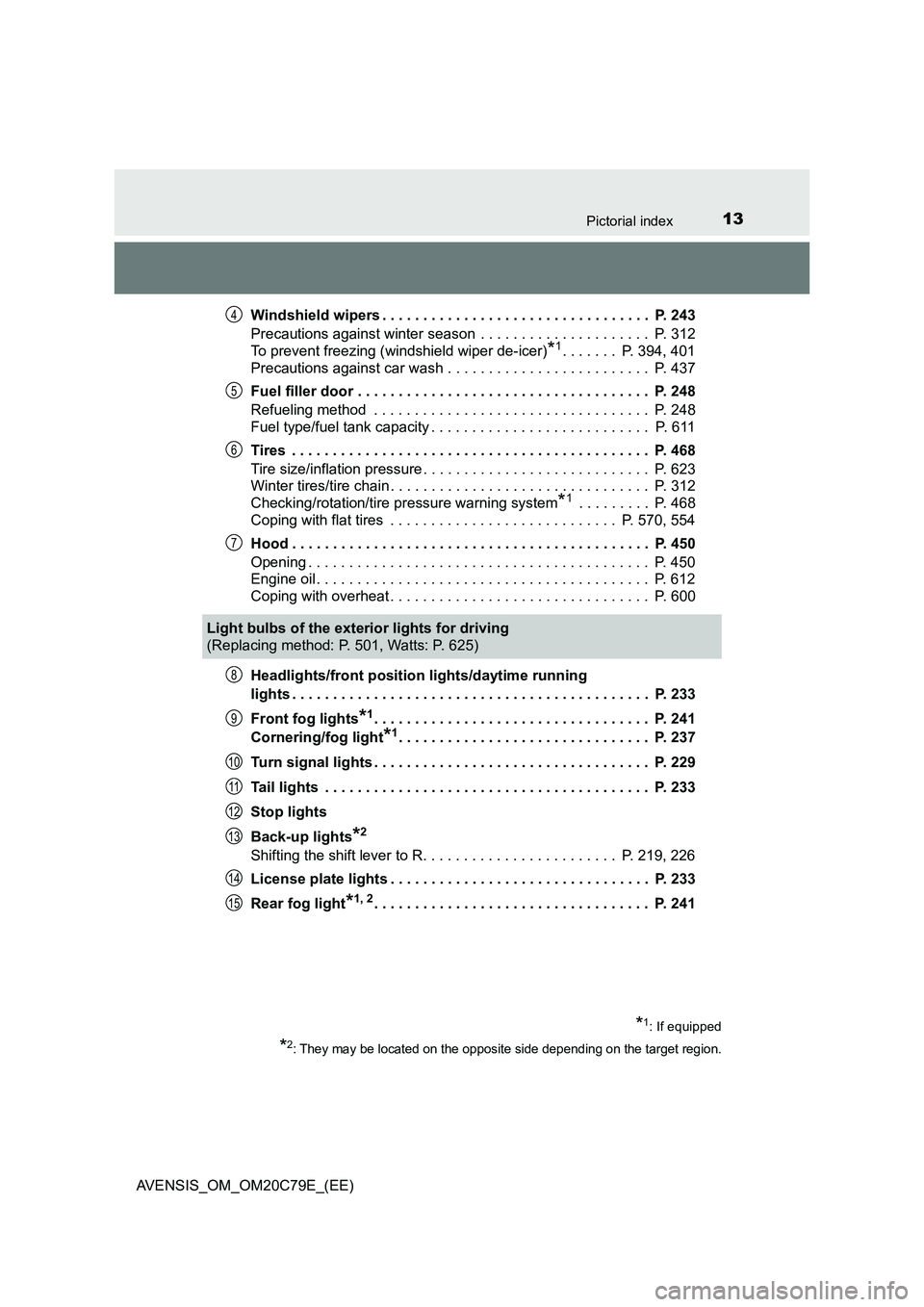
13Pictorial index
AVENSIS_OM_OM20C79E_(EE)Windshield wipers . . . . . . . . . . . . . . . . . . . . . . . . . . . . . . . . . P. 243
Precautions against winter season . . . . . . . . . . . . . . . . . . . . . P. 312
To prevent freezing (windshield wiper de-icer)
*1. . . . . . . P. 394, 401
Precautions against car wash . . . . . . . . . . . . . . . . . . . . . . . . . P. 437
Fuel filler door . . . . . . . . . . . . . . . . . . . . . . . . . . . . . . . . . . . . P. 248
Refueling method . . . . . . . . . . . . . . . . . . . . . . . . . . . . . . . . . . P. 248
Fuel type/fuel tank capacity . . . . . . . . . . . . . . . . . . . . . . . . . . . P. 611
Tires . . . . . . . . . . . . . . . . . . . . . . . . . . . . . . . . . . . . . . . . . . . . P. 468
Tire size/inflation pressure . . . . . . . . . . . . . . . . . . . . . . . . . . . . P. 623
Winter tires/tire chain . . . . . . . . . . . . . . . . . . . . . . . . . . . . . . . . P. 312
Checking/rotation/tire pressure warning system
*1 . . . . . . . . . P. 468
Coping with flat tires . . . . . . . . . . . . . . . . . . . . . . . . . . . . P. 570, 554
Hood . . . . . . . . . . . . . . . . . . . . . . . . . . . . . . . . . . . . . . . . . . . . P. 450
Opening . . . . . . . . . . . . . . . . . . . . . . . . . . . . . . . . . . . . . . . . . . P. 450
Engine oil . . . . . . . . . . . . . . . . . . . . . . . . . . . . . . . . . . . . . . . . . P. 612
Coping with overheat . . . . . . . . . . . . . . . . . . . . . . . . . . . . . . . . P. 600
Headlights/front position lights/daytime running
lights . . . . . . . . . . . . . . . . . . . . . . . . . . . . . . . . . . . . . . . . . . . . P. 233
Front fog lights
*1. . . . . . . . . . . . . . . . . . . . . . . . . . . . . . . . . . P. 241
Cornering/fog light
*1. . . . . . . . . . . . . . . . . . . . . . . . . . . . . . . P. 237
Turn signal lights . . . . . . . . . . . . . . . . . . . . . . . . . . . . . . . . . . P. 229
Tail lights . . . . . . . . . . . . . . . . . . . . . . . . . . . . . . . . . . . . . . . . P. 233
Stop lights
Back-up lights
*2
Shifting the shift lever to R. . . . . . . . . . . . . . . . . . . . . . . . P. 219, 226
License plate lights . . . . . . . . . . . . . . . . . . . . . . . . . . . . . . . . P. 233
Rear fog light
*1, 2. . . . . . . . . . . . . . . . . . . . . . . . . . . . . . . . . . P. 241
4
5
6
7
Light bulbs of the exterior lights for driving
(Replacing method: P. 501, Watts: P. 625)
*1: If equipped
*2: They may be located on the opposite side depending on the target region.
8
9
10
11
12
13
14
15
Page 15 of 660
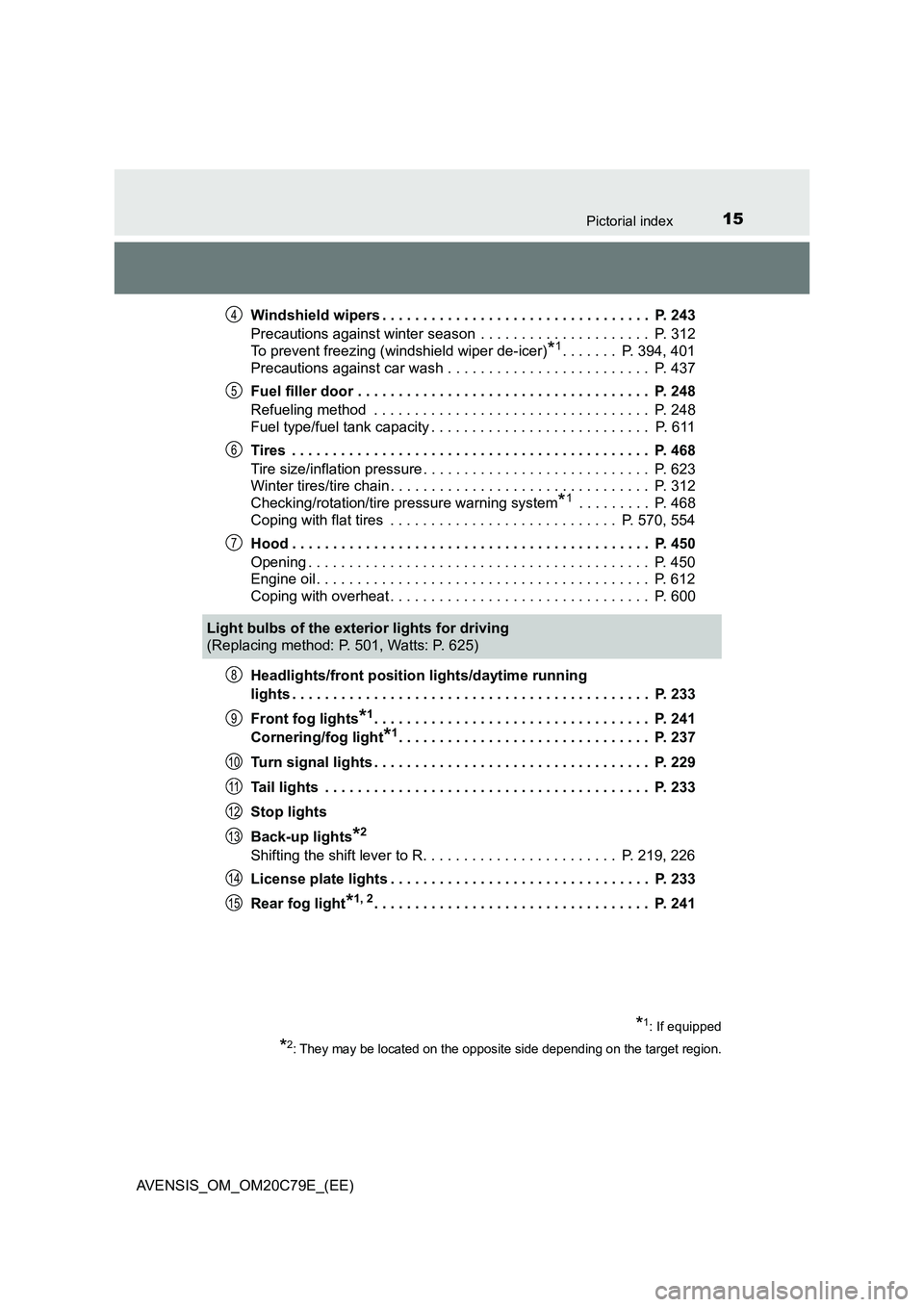
15Pictorial index
AVENSIS_OM_OM20C79E_(EE)Windshield wipers . . . . . . . . . . . . . . . . . . . . . . . . . . . . . . . . . P. 243
Precautions against winter season . . . . . . . . . . . . . . . . . . . . . P. 312
To prevent freezing (windshield wiper de-icer)
*1. . . . . . . P. 394, 401
Precautions against car wash . . . . . . . . . . . . . . . . . . . . . . . . . P. 437
Fuel filler door . . . . . . . . . . . . . . . . . . . . . . . . . . . . . . . . . . . . P. 248
Refueling method . . . . . . . . . . . . . . . . . . . . . . . . . . . . . . . . . . P. 248
Fuel type/fuel tank capacity . . . . . . . . . . . . . . . . . . . . . . . . . . . P. 611
Tires . . . . . . . . . . . . . . . . . . . . . . . . . . . . . . . . . . . . . . . . . . . . P. 468
Tire size/inflation pressure . . . . . . . . . . . . . . . . . . . . . . . . . . . . P. 623
Winter tires/tire chain . . . . . . . . . . . . . . . . . . . . . . . . . . . . . . . . P. 312
Checking/rotation/tire pressure warning system
*1 . . . . . . . . . P. 468
Coping with flat tires . . . . . . . . . . . . . . . . . . . . . . . . . . . . P. 570, 554
Hood . . . . . . . . . . . . . . . . . . . . . . . . . . . . . . . . . . . . . . . . . . . . P. 450
Opening . . . . . . . . . . . . . . . . . . . . . . . . . . . . . . . . . . . . . . . . . . P. 450
Engine oil . . . . . . . . . . . . . . . . . . . . . . . . . . . . . . . . . . . . . . . . . P. 612
Coping with overheat . . . . . . . . . . . . . . . . . . . . . . . . . . . . . . . . P. 600
Headlights/front position lights/daytime running
lights . . . . . . . . . . . . . . . . . . . . . . . . . . . . . . . . . . . . . . . . . . . . P. 233
Front fog lights
*1. . . . . . . . . . . . . . . . . . . . . . . . . . . . . . . . . . P. 241
Cornering/fog light
*1. . . . . . . . . . . . . . . . . . . . . . . . . . . . . . . P. 237
Turn signal lights . . . . . . . . . . . . . . . . . . . . . . . . . . . . . . . . . . P. 229
Tail lights . . . . . . . . . . . . . . . . . . . . . . . . . . . . . . . . . . . . . . . . P. 233
Stop lights
Back-up lights
*2
Shifting the shift lever to R. . . . . . . . . . . . . . . . . . . . . . . . P. 219, 226
License plate lights . . . . . . . . . . . . . . . . . . . . . . . . . . . . . . . . P. 233
Rear fog light
*1, 2. . . . . . . . . . . . . . . . . . . . . . . . . . . . . . . . . . P. 241
4
5
6
7
Light bulbs of the exterior lights for driving
(Replacing method: P. 501, Watts: P. 625)
*1: If equipped
*2: They may be located on the opposite side depending on the target region.
8
9
10
11
12
13
14
15
Page 99 of 660
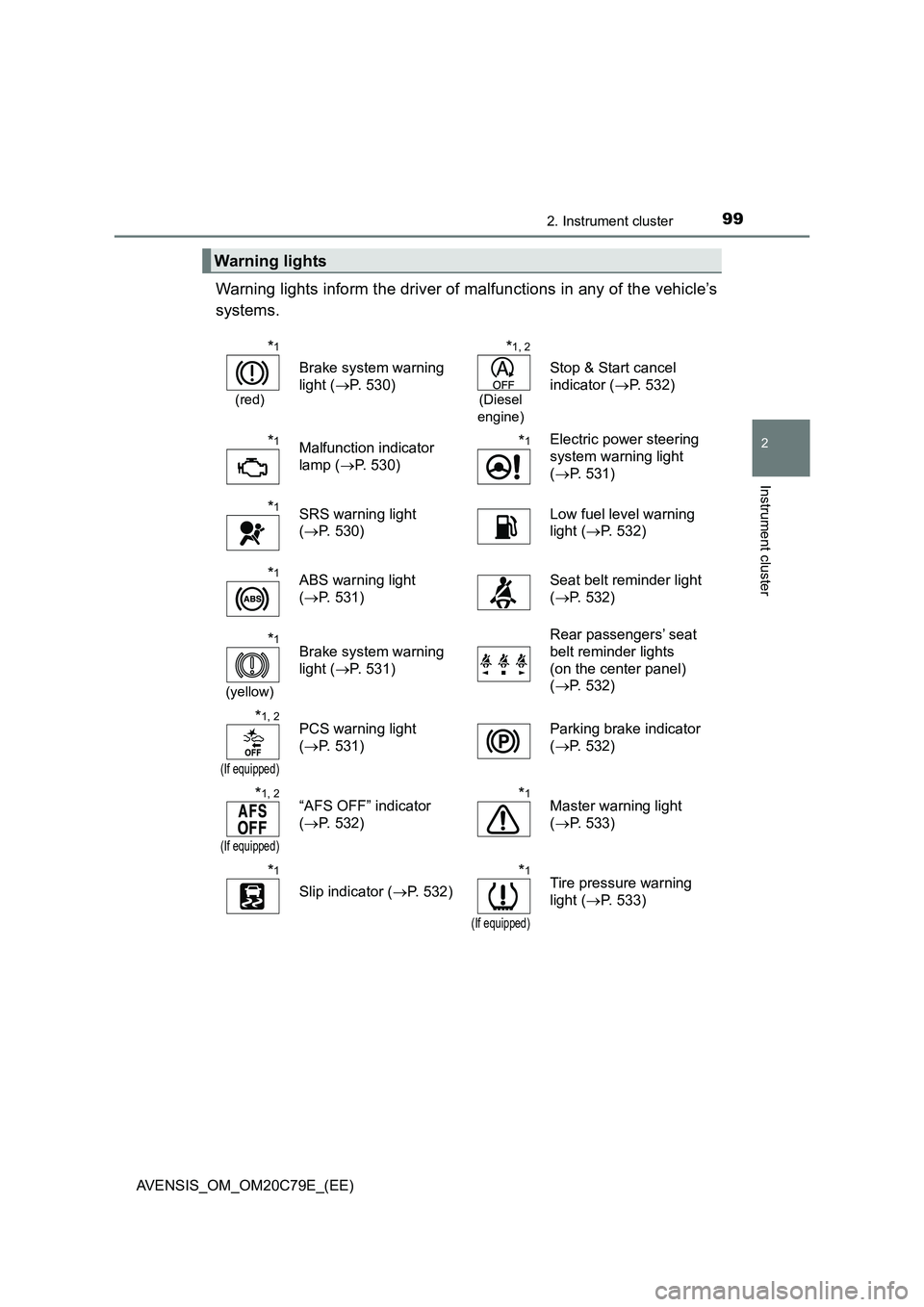
992. Instrument cluster
2
Instrument cluster
AVENSIS_OM_OM20C79E_(EE)
Warning lights inform the driver of malfunctions in any of the vehicle’s
systems.
Warning lights
*1
(red)
Brake system warning
light (P. 530)
*1, 2
(Diesel
engine)
Stop & Start cancel
indicator (P. 532)
*1Malfunction indicator
lamp (P. 530)*1Electric power steering
system warning light
(P. 531)
*1SRS warning light
(P. 530)Low fuel level warning
light (P. 532)
*1ABS warning light
(P. 531)Seat belt reminder light
(P. 532)
*1
(yellow)
Brake system warning
light (P. 531)Rear passengers’ seat
belt reminder lights
(on the center panel)
(P. 532)
*1, 2
(If equipped)
PCS warning light
(P. 531)Parking brake indicator
(P. 532)
*1, 2
(If equipped)
“AFS OFF” indicator
(P. 532)*1Master warning light
(P. 533)
*1
Slip indicator (P. 532)
*1
(If equipped)
Tire pressure warning
light (P. 533)
Page 109 of 660

1092. Instrument cluster
2
Instrument cluster
AVENSIS_OM_OM20C79E_(EE)When refueling, turn the engine switch to the “LOCK” position (vehicles
without smart entry & start system) or off (vehicles with smart entry &
start system).
If the vehicle is refueled without turning the engine switch to the “LOCK”
position or off, the display may not be updated.
●Average vehicle speed
Displays the average vehicle speed since the engine was last
started.
●Elapsed time
Displays the elapsed time since the engine was started.
●Setting
The settings of the following items can be changed.
• Language
Select to change the language on the display. (P. 629)
•Units
Select to change the units for measure of the fuel consumption and out-
side temperature. (P. 629)
• Eco Driving Indicator Light
Select to activate/deactivate the Eco Driving Indicator Light. (P. 109)
• Stop & start system
Select to change the stop & start system setting. (P. 295)
•Clock
Select to adjust the hours and minutes. (P. 110)
•Clock format
Select to change the clock format.
• Tire pressure warning system
Select to set up the tire pressure warning system. (P. 470)
●Average fuel consumption and Eco Driving Indicator Zone Display
(if equipped)
Displays the average fuel consumption since the function was reset.
Suggests Zone of Eco driving and Eco driving ratio based on accel-
eration.
■Eco Driving Indicator Zone Display (if equipped)
Zone of Eco driving Suggests Zone of Eco driving and Eco
driving ratio based on acceleration.
Eco driving ratio based on acceleration
If the acceleration exceeds Zone of Eco
driving, the right side of Eco Driving Indi-
cator Zone Display blinks and Eco Dri-
ving Indicator Light will turn off. (P. 103)
1
2
Page 114 of 660
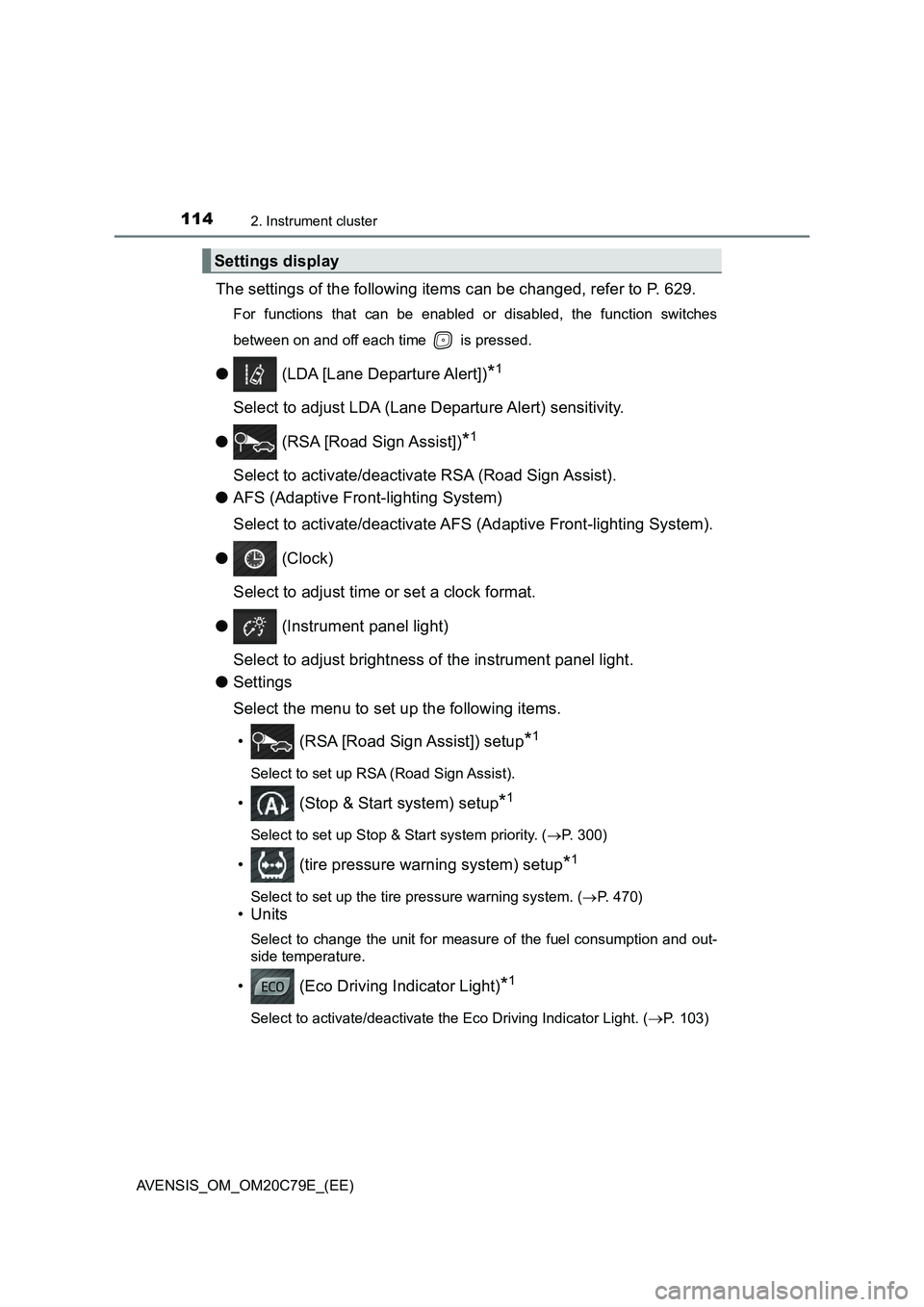
1142. Instrument cluster
AVENSIS_OM_OM20C79E_(EE)
The settings of the following items can be changed, refer to P. 629.
For functions that can be enabled or disabled, the function switches
between on and off each time is pressed.
● (LDA [Lane Departure Alert])*1
Select to adjust LDA (Lane Departure Alert) sensitivity.
● (RSA [Road Sign Assist])
*1
Select to activate/deactivate RSA (Road Sign Assist).
●AFS (Adaptive Front-lighting System)
Select to activate/deactivate AFS (Adaptive Front-lighting System).
● (Clock)
Select to adjust time or set a clock format.
● (Instrument panel light)
Select to adjust brightness of the instrument panel light.
●Settings
Select the menu to set up the following items.
• (RSA [Road Sign Assist]) setup
*1
Select to set up RSA (Road Sign Assist).
• (Stop & Start system) setup*1
Select to set up Stop & Start system priority. (P. 300)
• (tire pressure warning system) setup*1
Select to set up the tire pressure warning system. (P. 470)
•Units
Select to change the unit for measure of the fuel consumption and out-
side temperature.
• (Eco Driving Indicator Light)*1
Select to activate/deactivate the Eco Driving Indicator Light. (P. 103)
Settings display
Page 202 of 660

2024-1. Before driving
AVENSIS_OM_OM20C79E_(EE)
WARNING
■When the gross vehicle mass or maximum permissible axle capacity is
exceeded
Failing to observe this precaution may lead to an accident causing death or
serious injury.
● Add an additional 20.0 kPa (0.2 kgf/cm2 or bar, 3 psi) to the recommended
tire inflation pressure value. ( P. 623)
● Do not exceed the established speed limit for towing a trailer in built-up
areas or 100 km/h (62 mph), whichever is lower.
Page 205 of 660
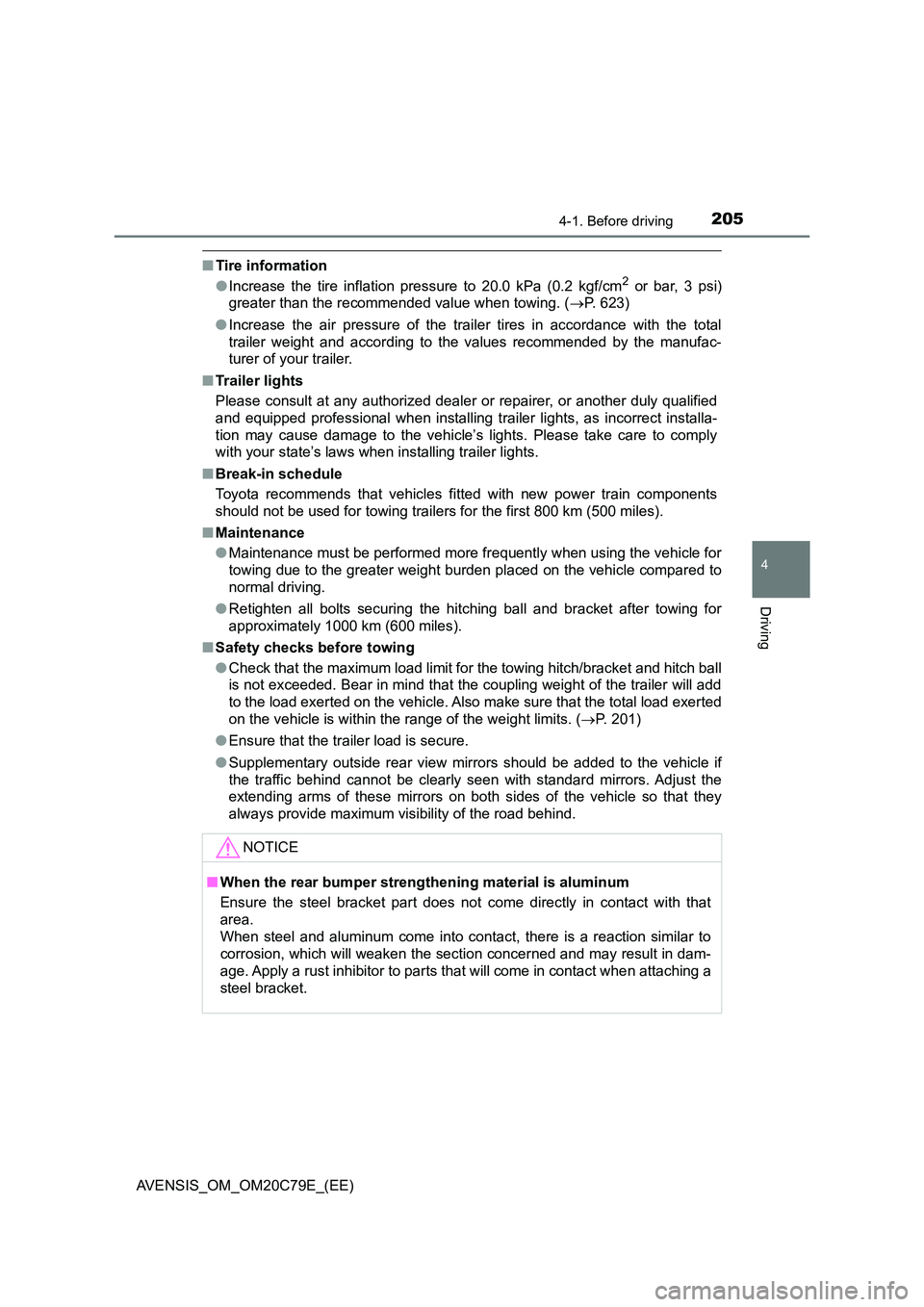
2054-1. Before driving
4
Driving
AVENSIS_OM_OM20C79E_(EE)
■Tire information
● Increase the tire inflation pressure to 20.0 kPa (0.2 kgf/cm2 or bar, 3 psi)
greater than the recommended value when towing. ( P. 623)
● Increase the air pressure of the trailer tires in accordance with the total
trailer weight and according to the values recommended by the manufac-
turer of your trailer.
■ Tr a i l e r l i g h ts
Please consult at any authorized dealer or repairer, or another duly qualified
and equipped professional when installing trailer lights, as incorrect installa-
tion may cause damage to the vehicle’s lights. Please take care to comply
with your state’s laws when installing trailer lights.
■ Break-in schedule
Toyota recommends that vehicles fitted with new power train components
should not be used for towing trailers for the first 800 km (500 miles).
■ Maintenance
● Maintenance must be performed more frequently when using the vehicle for
towing due to the greater weight burden placed on the vehicle compared to
normal driving.
● Retighten all bolts securing the hitching ball and bracket after towing for
approximately 1000 km (600 miles).
■ Safety checks before towing
● Check that the maximum load limit for the towing hitch/bracket and hitch ball
is not exceeded. Bear in mind that the coupling weight of the trailer will add
to the load exerted on the vehicle. Also make sure that the total load exerted
on the vehicle is within the range of the weight limits. ( P. 201)
● Ensure that the trailer load is secure.
● Supplementary outside rear view mirrors should be added to the vehicle if
the traffic behind cannot be clearly seen with standard mirrors. Adjust the
extending arms of these mirrors on both sides of the vehicle so that they
always provide maximum visibility of the road behind.
NOTICE
■ When the rear bumper strengthening material is aluminum
Ensure the steel bracket part does not come directly in contact with that
area.
When steel and aluminum come into contact, there is a reaction similar to
corrosion, which will weaken the section concerned and may result in dam-
age. Apply a rust inhibitor to parts that will come in contact when attaching a
steel bracket.
Page 270 of 660
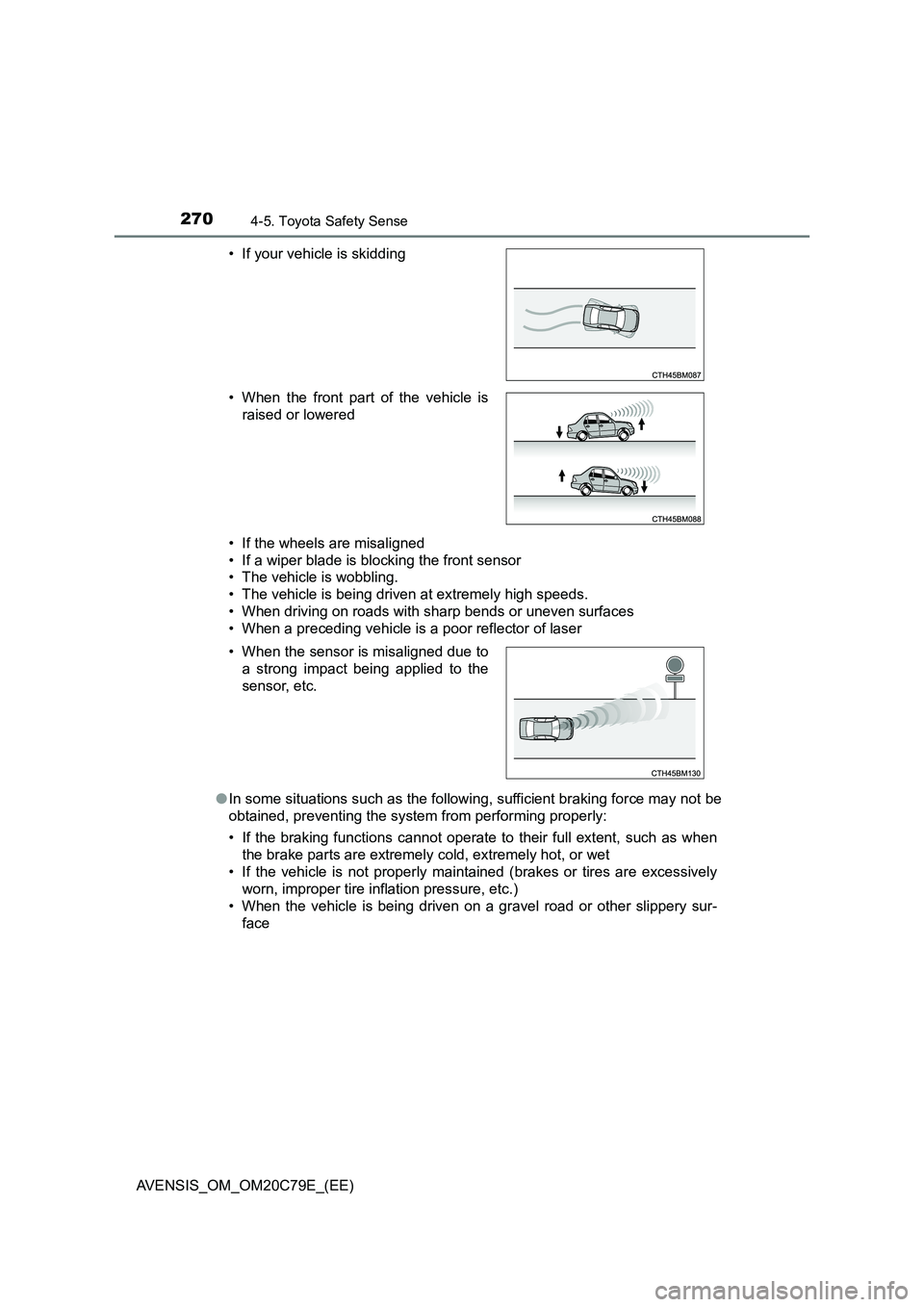
2704-5. Toyota Safety Sense
AVENSIS_OM_OM20C79E_(EE)
• If the wheels are misaligned
• If a wiper blade is blocking the front sensor
• The vehicle is wobbling.
• The vehicle is being driven at extremely high speeds.
• When driving on roads with sharp bends or uneven surfaces
• When a preceding vehicle is a poor reflector of laser
● In some situations such as the following, sufficient braking force may not be
obtained, preventing the system from performing properly:
• If the braking functions cannot operate to their full extent, such as when
the brake parts are extremely cold, extremely hot, or wet
• If the vehicle is not properly maintained (brakes or tires are excessively
worn, improper tire inflation pressure, etc.)
• When the vehicle is being driven on a gravel road or other slippery sur-
face
• If your vehicle is skidding
• When the front part of the vehicle is
raised or lowered
• When the sensor is misaligned due to
a strong impact being applied to the
sensor, etc.
Page 275 of 660
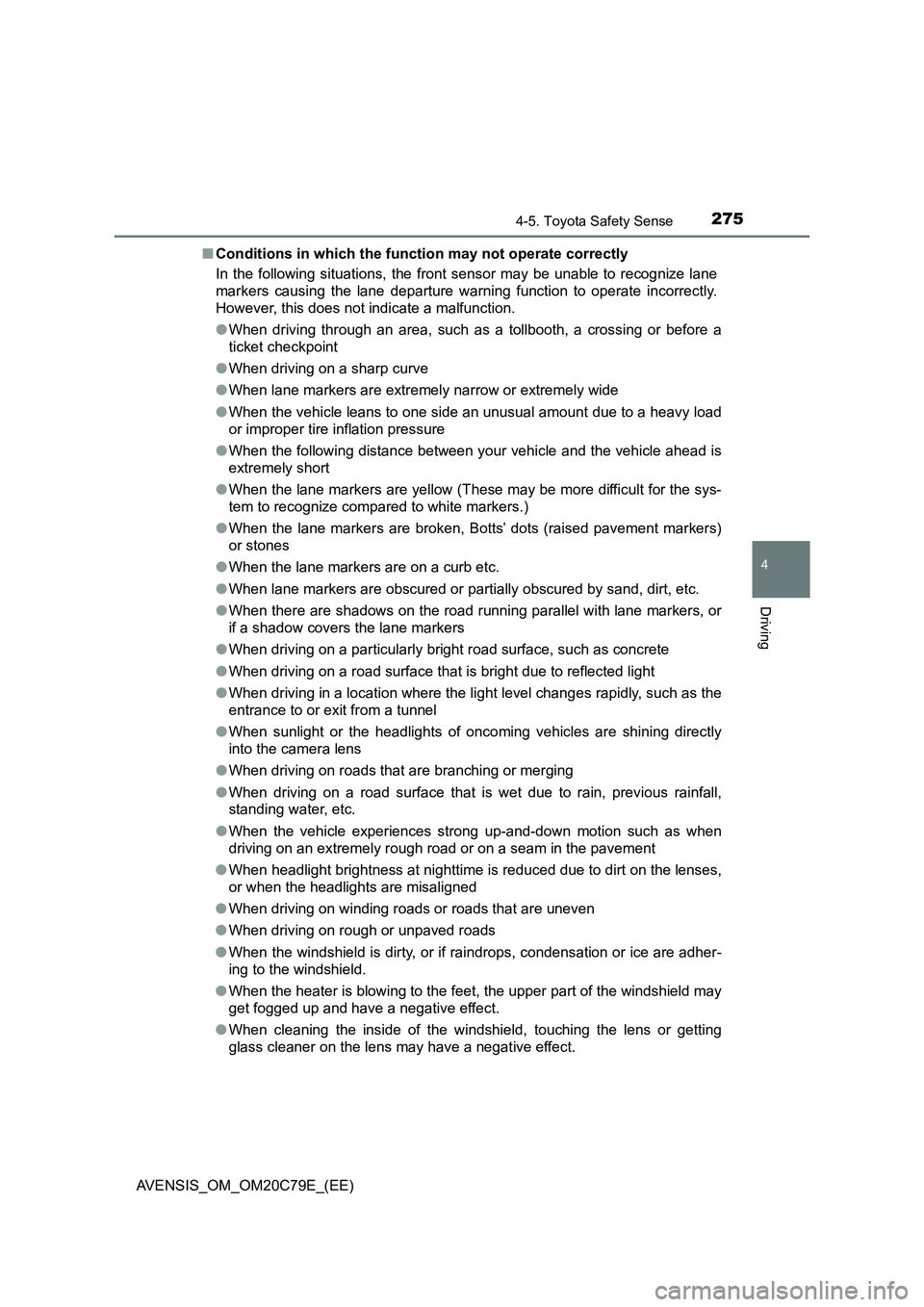
2754-5. Toyota Safety Sense
4
Driving
AVENSIS_OM_OM20C79E_(EE)■Conditions in which the function may not operate correctly
In the following situations, the front sensor may be unable to recognize lane
markers causing the lane departure warning function to operate incorrectly.
However, this does not indicate a malfunction.
●When driving through an area, such as a tollbooth, a crossing or before a
ticket checkpoint
●When driving on a sharp curve
●When lane markers are extremely narrow or extremely wide
●When the vehicle leans to one side an unusual amount due to a heavy load
or improper tire inflation pressure
●When the following distance between your vehicle and the vehicle ahead is
extremely short
●When the lane markers are yellow (These may be more difficult for the sys-
tem to recognize compared to white markers.)
●When the lane markers are broken, Botts’ dots (raised pavement markers)
or stones
●When the lane markers are on a curb etc.
●When lane markers are obscured or partially obscured by sand, dirt, etc.
●When there are shadows on the road running parallel with lane markers, or
if a shadow covers the lane markers
●When driving on a particularly bright road surface, such as concrete
●When driving on a road surface that is bright due to reflected light
●When driving in a location where the light level changes rapidly, such as the
entrance to or exit from a tunnel
●When sunlight or the headlights of oncoming vehicles are shining directly
into the camera lens
●When driving on roads that are branching or merging
●When driving on a road surface that is wet due to rain, previous rainfall,
standing water, etc.
●When the vehicle experiences strong up-and-down motion such as when
driving on an extremely rough road or on a seam in the pavement
●When headlight brightness at nighttime is reduced due to dirt on the lenses,
or when the headlights are misaligned
●When driving on winding roads or roads that are uneven
●When driving on rough or unpaved roads
●When the windshield is dirty, or if raindrops, condensation or ice are adher-
ing to the windshield.
●When the heater is blowing to the feet, the upper part of the windshield may
get fogged up and have a negative effect.
●When cleaning the inside of the windshield, touching the lens or getting
glass cleaner on the lens may have a negative effect.